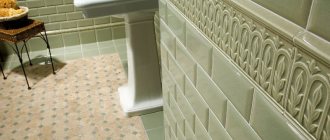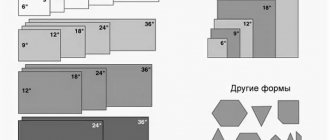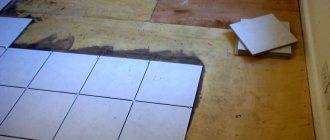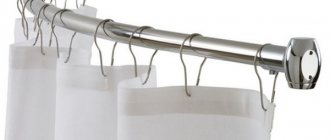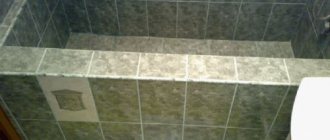Tiles with a three-dimensional image are increasingly used in home interior design, noticeably displacing traditional tiles. It is most in demand when decorating kitchens, hallways, bathrooms and, of course, bathrooms. Bright three-dimensional drawings look very realistic, which gives the room a completely different atmosphere. In terms of technical characteristics, 3D tiles are in many ways superior to ceramics, and a rich assortment makes it possible to choose the best option for every taste.
Ceramic 3d tiles
Features of material manufacturing
3D tiles for the bathroom, photos of samples of which can be found in the gallery of this article, are a multi-layer product that allows you to create a three-dimensional pattern on the walls. This effect is achieved through the use of special microlens technology. As a rule, ceramic or plastic samples are covered with carbon film. The illusion of a three-dimensional image is provided by polycarbonate layers.
3d tiles in the bathroom interior
The base is made of polycarbonate. It is covered with a shock-absorbing layer on top, after which a reflective film with a pattern is applied. The topmost, ultra-transparent layer acts as a lens, making the picture on the facing element three-dimensional. For greater strength, such a material is additionally coated with a protective shockproof layer. It makes the product reliable and wear-resistant.
Criteria for choosing 3D tiles
Three-dimensional ceramic tiles are decorative elements, so when choosing, you should first of all pay attention to the artistic part. When decorating small rooms, a large amount of material is not required; an excess of color spots will visually reduce the space. Large 3D paintings are used only in large rooms or on the floor/ceiling. The small ornament will fit perfectly into a bathroom or hallway. Before purchasing tiles with images of animals or people, you need to take into account that such artistic finishing options quickly become boring.
Properties of 3d tiles
Such models for finishing a bathroom have all the advantages of conventional ceramics. The only thing to remember is to be extremely careful when handling the outer carbon coating. This film, which creates the 3D effect, does not tolerate strong impacts. The optical image is distorted or completely disappears due to mechanical damage.
Plastic materials are quite moisture resistant. However, the relief on them cannot be scratched. When deformed, they will lose their attractive appearance and will not be glossy.
Volumetric tiles in the form of crystals
Chips on the product change the boundaries of the design applied to the surface.
And yet, manufacturing companies claim that if the operating rules are followed, 3D bathroom tiles, photos of which are presented on our website, can last more than 25 years without losing their strength and beauty.
Procedure for laying 3D tiles on the floor
Each type of product uses its own laying technology .
Opaque and translucent tiles are laid on the subfloor using an adhesive mixture. For a transparent product, special profiles and lighting devices are used. Since trimming a 3D product is impossible, its quantity and installation method must be very accurately calculated. The rough floor covering is prepared for all types of tiles in the same way, keeping the room temperature from +5 to + 36 degrees. A concrete or cement screed, without visible defects, mold and mildew, is suitable.
All pits, bumps and cracks are eliminated, the surface is sanded and, if necessary, filled with a self-leveling mixture . The surface must be completely dry, and the day before laying the tiles, it must be moistened with water and washed. Next, a dispersion primer is used to cover the surface for better adhesion of the screed to the adhesive mixture. After 20-30 minutes, you can begin laying 3D tiles on the surface.
Make a drawing in advance of how the tiles will be laid on the floor; you need to calculate everything down to the millimeter. If this is a drawing, then on the subfloor you can mark the place where it will be placed. Laying 3D bathroom tiles is a serious matter.
If the 3D tiles in the bathroom (see photo below) will be laid in a checkerboard pattern, then you need to determine the center of the surface and start laying from there. The center is determined by two perpendicular lines, strictly at an angle of 90 degrees; a level or level is used for this.
If you have never done such work, then it is better to entrust the installation of expensive 3D tiles for the bathroom to a specialist .
Pros and cons of optical effect cladding products
The design of 3D products is diverse. In addition to high aesthetic properties, this type of finishing has other advantages:
- does not slip;
- resistant to fire;
- has good waterproofing properties;
- will last a long time;
- easy to clean, not afraid of aggressive household chemicals;
- can withstand heavy loads - up to 200 kg per square centimeter;
- hypoallergenic material;
- not susceptible to mold fungi.
These products have several disadvantages:
- It is not recommended to cut such tiles when laying them, since the material should not be altered;
- application is possible only indoors - this is a finishing material only for interiors;
Bathroom design in 3d style
Before you start laying ceramic tiles, you need to choose the type of adhesive composition. Depending on the type of facing tiles, there are different mixtures. As a rule, they are made based on silicone, cement or gypsum. Special double-sided adhesive tape or heat-resistant mixtures are also used to finish the heated floor system.
It is better to think in advance which glue is ideal for a particular type of ceramic. Manufacturers often write the relevant requirements in the instructions. These should be taken into account to ensure secure installation without the products coming off.
3d tiles: properties, characteristics, applications
To produce tiles with a 3D effect, impact-resistant tempered glass, ceramics or polycarbonate are used as the base, and special microlens technology is used to apply the image. Depending on the material, the methods of applying the pattern have certain differences, and the products themselves can be transparent, translucent or matte. Translucent models contain a colored gel filler, which changes shape when pressed, and the pattern seems to come to life under your feet.
Ceramic and polycarbonate based tiles have a multi-layer structure:
- base layer;
- shock-absorbing layer;
- reflective layer with a pattern;
- a transparent layer that performs the functions of a lens;
- protective shockproof coating made of carbon film.
Parabolic lenses not only add volume to the picture, but also create the effect of movement, which is especially noticeable on tiles with a geometric pattern.
Tiles in 3D format: its varieties
When making glass products, microlenses are applied to the surface during the casting process, and after hardening, a coded image is made on the back side of the tile and covered with a protective layer. This technology, in addition to the effect of movement, creates the illusion of changing the size of the picture, gives the image depth, and adds shine and shimmer.
| Specifications | Options |
| Dimensions, mm | 210x330, 250x500, 330x330, 330x500, 450x450, 678x988 |
| Thickness, mm | 4-10 |
| Weight (kg/m2) | 9-9,5 |
| Abrasion resistance | high |
| Operating temperature range | from -20 to +100 degrees Celsius |
| Elasticity coefficient | up to 73,500 MPa |
| Resistance to mechanical loads | up to 200 kg/cm2 |
| Chemical resistance | high |
| Moisture resistance | high |
| Deviations in tile sizes | 0.3-0.5 mm |
3D tiles are suitable for use in almost all rooms, including residential ones. Like ordinary ceramics, it is completely safe for health. There are three types of such tiles - floor, wall and panels. It goes well with tiles, artificial and natural stone, ceramic and glass mosaics.
Features of the selection and installation of ceramic 3D tiles
Important! Due to the peculiarities of the structure, tiles with a three-dimensional image are laid only as a whole; cutting it into fragments is not recommended. Products with gel filler completely lose their properties when cut; with other types of tiles, it is difficult to align the lines of the pattern on the cuts, which causes distortion of the picture.
3d floor tiles for bathroom
Construction stores offer a wide range of floor coverings.
3d tiles on the bathroom floor
For example, transparent models are used to create an original backlit flooring design. There are also translucent tiles. It contains a liquid filler, due to which, when pressed on the surface of the product, one of the layers is compressed, and the pattern on the floor becomes dynamic, as if “alive.”
Floor and wall 3D covering
3D tiles for bathroom flooring
When purchasing a coating, always pay attention to where you intend to mount it: on the floor, walls or ceiling. Each collection is suitable for two or all types of installation. But at the same time, the composition of the coating dictates its specific type of glue. This can be a silicone, gypsum fixer or cement-based adhesive, a heat-resistant liquid for installing tiles on heated floors. And in special cases, 3D bathroom tiles are attached to the floor with special double-sided tape.
Bathroom wall cladding
When choosing fashionable “voluminous” tiles for bathroom walls, you should be guided by the principle of moderation.
Wall decoration with 3d tiles
Too large images will visually make a not very large room look like a closet. In addition, such large patterns can look tacky and will seem intrusive after a while.
What bathroom tiles can be, photos, 3D image designs and their various combinations can be seen on our website. These types of ceramics can be combined with regular tiles. It is only necessary that all decorative elements of the floor and walls are in harmony and are designed in the same style.
Large 3d drawing in a small bathroom
It is recommended to lay ceramic models with a 3D effect on perfectly leveled surfaces. Minor wall defects spoil the overall appearance of the cladding.
Tile 3D
Creating an original modern design in a bathroom or toilet using three-dimensional drawings is a fashionable modern trend. This type of finish simply amazes with its unusual appearance.
When choosing a finishing material, you need to take into account such parameters as:
- Color solution;
- Image style;
- Image and tile size.
When choosing a color, it is worth considering the size of the room itself. If it is small in size, then you should not buy tiles in too bright colors, as this will visually make the room smaller and will not look very harmonious. When choosing the style of an image, you need to take into account that it should fit harmoniously into the overall interior design and emphasize the functional purpose of the room. A marine or beach theme is ideal for a bathroom. The effect of spilled water looks very advantageous, which will create the feeling of being on the sea coast.
Before buying 3D tiles, you should familiarize yourself with the advice of designers
In addition, when choosing tiles, you need to take into account the size of the pattern and the tile itself. If you need to make the room visually more spacious, then you should choose a slab with a small pattern and the size of the tile itself should also not be large. Large drawings will only visually reduce the space.
Important! When choosing three-dimensional tiles, you must take into account the overall style of the bathroom, as well as the color scheme, so that all materials and other interior items are combined with each other.
Against the background of tiles with a three-dimensional image, other decorations and additional accessories will look quite ridiculous. That is why it is recommended to minimize the number of additional decorations. If the bathroom area is large, then you can make absolutely all your desires come true.
How to care for volumetric tiles
The main rule is to avoid mechanical damage to the outer coating. This is especially important for wall tiles. Finishing materials for the floor are characterized by greater wear resistance and are not so easy to scratch. The design on such a tile should not be erased over time.
Panel on the wall with a three-dimensional image effect
3D tiles for lining the ceiling and walls of the bathroom can be washed with water and wiped dry with a soft cloth.
In this case, even mild cleaning agents and powders should not be used, since they remove a special layer on its surface and reduce the voluminous effect of the patterns.
A soap solution is also contraindicated for cleaning products. It will leave stains on the outer carbon film, which are not easy to get rid of later.
One of the acceptable cleaning solutions for such tiles is acid-containing compounds. However, if the substance comes into contact with the glazed top layer, damage to the decorative coating with the applied image may occur. Therefore, the cleaning agent should be washed off quickly. It is advisable to purchase special compounds for the care of this tile.
Structure of 3D floor tiles
3D floor tiles are a modern finishing material, available in a wide range, so it is possible to choose the required model. This material is based on a special microlens technology. This means that thanks to the combination of carbon tiles and tiles, it is possible to achieve a three-dimensional effect.
The surface of this material is wear-resistant and elastic. Inside the product there is a liquid component diluted with single-color or multi-color dyes.
You should not use 3D floor tiles that are too bright, as they will tire your eyes.
Its structure consists of several layers of polycarbonate, namely:
- Base;
- Depreciation;
- Reflective;
- Polymeric.
The gel structure is located between two protective layers. A special protective composition and durable tile layers can withstand significant loads and dirt. Pressing the surface of the tile helps create the most attractive image possible, creating the illusion of three-dimensionality. The design can be in the form of pictures, abstract spots or geometric shapes.
Application of 3D tiles in the interior of a bathroom
Creating an original design in the bathroom using three-dimensional images is a new fashionable trend. This type of bathroom decoration can become a source of pride for the owners. Three-dimensional drawings on the walls are unusual, bright, interesting.
A variety of thematic pictures allows the owner of the bathroom to turn the room into some kind of sea coast or even create an entire “underwater world”. Today on sale there are many options for volumetric decoration of facing products with a water theme: sea waves, shells, images of multi-colored exotic fish and other ocean inhabitants. This design will certainly not leave the guests of your home indifferent.
Sea shells on the bathroom floor
Of course, a lot depends on personal preference. To some citizens, such an interior will seem like “pampering.” You can visually enlarge the bathroom space and make its design sophisticated with the help of ordinary tiles. It is only important to figure out what kind of bathroom you want to see in your apartment, outline the project and style solution. In accordance with it, it is worth determining for yourself how to use 3D tiles during repairs.
All the qualities of this finishing material are no different from the properties of standard tiles, but the extraordinary appearance of three-dimensional tiles is its main advantage.
Volumetric mosaic
The opportunity to decorate the bathroom interior in an unusual way certainly ensures that such products are becoming increasingly popular.
A geometric or raster image creates the effect of volumetric space; drawn elements and figures seem real, “alive.”
3D images in the interior
In bathroom interior design, designers are increasingly using 3D images. Three-dimensional pictures allow you to create a truly unique interior that can capture the imagination of anyone.
Imagine, a guest opens the door to the bathroom, and in front of him the abyss of the sea with numerous inhabitants opens up - unexpectedly and, you see, very impressive! Such an interior will definitely not leave any person indifferent.
There will be those who will say that this type of bathroom design is a waste of time and money, because you can change the look of the bathroom using ordinary ceramic tiles.
This type of cladding has proven itself to be very practical in the building materials market:
- firstly, dirt can be washed off quite easily from the ceramic surface;
- secondly, ceramic tiles are resistant to moisture;
- thirdly, modern ceramic tiles have very high aesthetic properties
Using ceramic tiles in the bathroom interior
However, for people who strive for originality in the bathroom interior, it is not enough to use materials that have already become traditional. The properties of 3D tiles are in no way inferior to ceramic ones, and in terms of aesthetics they are in many ways superior to them.
Product selection rules
The main functions of this tile, like any other type of tile, are as follows:
- decorate the bathroom interior, hiding the shortcomings of the room;
- act as a convenient, easy-to-clean covering for floors and walls.
If the bathroom has a limited area, you need to choose the right color scheme for the products. It is better to purchase tiles of a lighter shade with a minimum number of bright large accents.
Design in one color scheme
Flashy decorative elements and accessories will only further “steal” the space. They should only be used for finishing large rooms. In this case, you can safely show your imagination.
Selection, installation and care of coating
In order to determine the texture, geometric parameters and other selection criteria, you need to plan the overall design idea, as well as know the area of the room. A 3D picture visually expands the space, however, when decorating, it is better to use a small fragment that will look more impressive.
3D tiles in the shower
There are exceptions to every rule, so for owners of a large bathroom it is permissible to experiment and fulfill the dream of many people - to completely tile the room. At the same time, the main thing is to focus on a harmonious combination with the interior of the house and correctly place the necessary accents. As for the choice of manufacturers, price or design, here you need to proceed from your budget, taste and preferences.
Despite the unusual properties, the tiles are laid on the floor and walls in the same way as ordinary ceramics. Even a non-specialist can install it with his own hands, following a few simple rules. Laying must be carried out on a flat, clean and dry surface with a certain gap between the elements. After which the joints are grouted using transparent silicone.
If you prefer a backlit bathroom floor, then first work is done to install the electrical circuit, then install guides made of plexiglass or polycarbonate, leaving a gap of no more than 3-4 mm between them so that the overall picture is not deformed. Thus, each element is sequentially laid out until a solid pattern is created. The main condition for caring for the material comes down to caring for the surface layer.
Laying tiles
Fastening trendy volumetric material does not require special skills. To install, you need to prepare the 3D tile itself, glue or double-sided tape. It is also important to level and thoroughly clean the facing surface.
The tiles are fixed on special guides made of polycarbonate or plexiglass. Seams should be left between the products, which are then sealed with a transparent silicone-based sealant.
Despite the fact that 3D ceramics has not yet managed to win the trust of most buyers, its use in bathroom design really allows you to create a unique, unusual design that will appeal to many.
There are a large number of style options with this type of material. The only requirement when choosing such products is a sense of taste and proportion. The main thing is to choose something that suits your bathroom, will be able to harmonize with other decorative elements and will make the room beautiful and comfortable. This type of tile will transform a standard boring room beyond recognition.
3d tiles in the bathroom interior Volumetric tiles in the form of crystals Bathroom design in 3d style 3d tiles on the bathroom floor Large 3d drawing in a small bathroom Wall decoration with 3d tiles Design in the same color scheme Sea shells on the bathroom floor Panel on the wall with the effect of a three-dimensional image Volumetric mosaic
Original bathroom tiling with 3d tiles
Volumetric tiles with a marine-themed pattern
Coating features
If we consider the premises of a house or apartment, then it is used in the bathroom, kitchen or hallway. It is not recommended to lay 3D tiles in a residential area.
When choosing tiles for recommended rooms, you need to consider:
- Room size. You cannot use tiles of bright colors in a small room. It will visually make the room smaller and may become boring over time.
- Drawing. Depending on where the tiles will be laid, the corresponding pattern is selected. A marine or beach theme is suitable for the bathroom; the corridor can be decorated with various landscapes; and for the kitchen, pictures depicting fruits, beautiful food and flowers will be relevant.
- Dimensions of the product and possible design. To visually enlarge the room, it is recommended to take small tiles with a medium-sized pattern.
If you lay 3D tiles on the floor in a large room, then the number of accessories will need to be limited. A larger room provides more opportunities for experimentation. You can choose tiles of any color and shape with the pattern you like.
Design
3D wall tiles “Spruce”
When choosing three-dimensional tiles, we pursue two goals: decorating the interior and hiding possible shortcomings of the current design. It is recommended to use such finishing material carefully; for all its aesthetics and beauty, it “eats up” part of the space. 3D tiles for the bathroom are a great option, but in average apartments, bathrooms have a small area. Therefore, local lining may be appropriate. In spacious rooms, visual reduction is not a problem, and here the use of three-dimensional tiles is rather a matter of finances.
As for the range that the manufacturer can offer, it is, for natural reasons, inferior to the variety of ceramic tiles. However, more does not mean better. And the dozens of species that can be found on sale will satisfy, perhaps, any consumer. Design examples in the video:
What can you combine tiles with in the toilet?
To make the design more interesting, combine tiles with other materials:
- wallpaper: regular and with perspective effect;
- printed glass;
- mosaic panel;
- microcement;
- marble - for a classic style;
- painted surfaces;
- tree;
- brick - for loft style.
You can also use combinations of different textures: glossy and matte, and combinations of tiles of different sizes and shades.
If you are just looking for ideas for renovation and arrangement or already know for sure that a toilet is your option, we have collected for you 11,393 photos from real projects of interior designers, decorators and architects from Russia and around the world, including such proven professionals as Remodel and MY_YODesign. The beautiful toilets in our photographs are the best examples of competent design and layout in different styles and colors. If you like any design option, for example the toilet from the second photo, you can contact the author and order the ideal design project for yourself. See our photo gallery, look for inspiration and professionals, and you will see why Houzz is the best resource for apartment and home interior design, renovation, home construction, architecture and landscape design.

